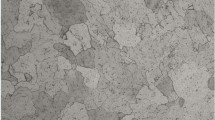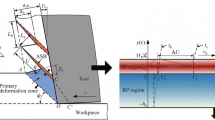Abstract
The formation of isolated segment chip due to the occurrence of adiabatic shear fracture (ASF) in adiabatic shear band (ASB) is a significant phenomenon under the high cutting speed. In the present work, the experimental and theoretical methods were adopted to further investigate the energy convergence characteristics in ASB during ASF process in high-speed machining. A hardened stainless steel used in turbine blade was selected as the workpiece. The chip morphology transformation from serrated chip to isolated segment chip was obtained through the high-speed machining experiment. The ductile crack propagation in ASB was observed microscopically. The relations of serrated segment geometry with the cutting conditions were revealed experimentally. According to the continuum governing equations and the deformation and energy analytical models, the distributions of shear velocity, shear strain rate, shear strain, and shear energy in ASB under various cutting speeds and feeds were analyzed combining with the constitutive and stress relations. The energy convergence characteristics in ASB during ASF process with the change of cutting conditions were analyzed and discussed. The results showed that the austenite blocks in the hardened stainless steel influenced the crack propagation in ASB. The larger shear strain induced thinner ASB would accelerate the thermal softening and strain localizing effects, resulting in severer energy convergence in ASB. The energy convergence was uniformly distributed and always kept a constant limit value in the whole ASB when ASF occurred.
Similar content being viewed by others
References
Recht R (1964) Catastrophic thermoplastic shear. J Appl Mech 31:189–193
Komanduri R, Schroeder T, Hazra J, Von Turkovich B, Flom D (1982) On the catastrophic shear instability in high-speed machining of an AISI 4340 steel. J Eng Ind Trans ASME 104:121–131
Gu L, Wang M, Duan C (2013) On adiabatic shear localized fracture during serrated chip evolution in high speed machining of hardened AISI 1045 steel. Int J Mech Sci 75:288–298
Gg Y, Xue S, Mq J, Tong X, Dai L (2013) Modeling periodic adiabatic shear band evolution during high speed machining Ti-6Al-4V alloy. Int J Plast 40:39–55
Ma W, Chen X, Shuang F (2017) The chip-flow behaviors and formation mechanisms in the orthogonal cutting process of Ti6Al4V alloy. J Mech Phys Solids 98:245–270
Gente A, Hoffmeister H, Evans C (2001) Chip formation in machining Ti6Al4V at extremely high cutting speeds. CIRP Ann Manuf Technol 50:49–52
Minjie W, Chunzheng D, Hongbo L (2004) Experimental study on adiabatic shear behavior in chip formation during orthogonal cutting. Chin J Mech Eng 18:7–10
Derby B (1991) The dependence of grain size on stress during dynamic recrystallisation. Acta Metall Mater 39:955–962
Hines JA, Vecchio KS, Ahzi S (1998) A model for microstructure evolution in adiabatic shear bands. Metall Mater Trans A 29:191–203
Duan C, Wang M (2013) A review of microstructural evolution in the adiabatic shear bands induced by high speed machining. Acta Metall Sin (Engl Lett) 26:97–112
He N, Lee T, Lau W, Chan S (2002) Assessment of deformation of a shear localized chip in high speed machining. J Mater Process Technol 129:101–104
Duan C, Wang M, Pang J, Li G (2006) A calculational model of shear strain and strain rate within shear band in a serrated chip formed during high speed machining. J Mater Process Technol 178:274–277
Dong G, Zhaopeng H, Rongdi H, Yanli C, Muguthu JN (2011) Study of cutting deformation in machining nickel-based alloy Inconel 718. Int J Mach Tools Manuf 51:520–527
Tounsi N, Vincenti J, Otho A, Elbestawi M (2002) From the basic mechanics of orthogonal metal cutting toward the identification of the constitutive equation. Int J Mach Tools Manuf 42:1373–1383
Sartkulvanich P, Koppka F, Altan T (2004) Determination of flow stress for metal cutting simulation—a progress report. J Mater Process Technol 146:61–71
Chandrasekaran H, M'saoubi R, Chazal H (2005) Modelling of material flow stress in chip formation process from orthogonal milling and split Hopkinson bar tests. Mach Sci Technol 9:131–145
Pujana J, Arrazola P, M’saoubi R, Chandrasekaran H (2007) Analysis of the inverse identification of constitutive equations applied in orthogonal cutting process. Int J Mach Tools Manuf 47:2153–2161
Elbestawi M, Srivastava A, El-Wardany T (1996) A model for chip formation during machining of hardened steel. CIRP Ann Manuf Technol 45:71–76
Poulachon G, Moisan A (2000) Hard turning: chip formation mechanisms and metallurgical aspects. J Manuf Sci Eng 122:406
Wang B, Liu Z (2014) Investigations on the chip formation mechanism and shear localization sensitivity of high-speed machining Ti6Al4V. Int J Adv Manuf Technol 75:1065–1076
Guo Y, Yen D (2004) A FEM study on mechanisms of discontinuous chip formation in hard machining. J Mater Process Technol 155:1350–1356
Hua J, Shivpuri R (2004) Prediction of chip morphology and segmentation during the machining of titanium alloys. J Mater Process Technol 150:124–133
Obikawa T, Usui E (1996) Computational machining of titanium alloy—finite element modeling and a few results. J Manuf Sci Eng 118:208–215
Tang D, Wang C, Hu Y, Song Y (2009) Finite-element simulation of conventional and high-speed peripheral milling of hardened mold steel. Metall Mater Trans A 40:3245–3257
Lin Z, Lin Y (2001) Elastic-plastic finite element analysis for oblique cutting with a discontinuous chip of 6-4 brass. J Strain Anal Eng Des 36:579–594
Xie J, Bayoumi A, Zbib H (1996) A study on shear banding in chip formation of orthogonal machining. Int J Mach Tools Manuf 36:835–847
Gu L, Kang G, Chen H, Wang M (2016) On adiabatic shear fracture in high-speed machining of martensitic precipitation-hardening stainless steel. J Mater Process Technol 234:208–216
Barry J, Byrne G, Lennon D (2001) Observations on chip formation and acoustic emission in machining Ti6Al4V alloy. Int J Mach Tools Manuf 41:1055–1070
Lee W-S, Chiu C-C (2006) Deformation and fracture behavior of 316L sintered stainless steel under various strain rate and relative sintered density conditions. Metall Mater Trans A 37A:3685–3696
Giovanola J (1988) Adiabatic shear banding under pure shear loading part ii: fractographic and metallographic observations. Mech Mater 7:73–87
Sutter G, Faure L, Molinari A, Delime A, Dudzinski D (1997) Experimental analysis of the cutting process and chip formation at high speed machining. Le Journal de Physique IV 7:3–3
Molinari A, Musquar C, Sutter G (2002) Adiabatic shear banding in high speed machining of Ti-6Al-4V: experiments and modeling. Int J Plast 18:443–459
Gu L, Wang M (2013) Experimental and theoretical research on critical characteristics for adiabatic shear localization fracture in high-speed machining. Int J Adv Manuf Technol 68:1231–1240
Ozel T, Breve R, Zeren E (2006) A methodology to determine work material flow stress and tool-chip interfacial friction properties by using analysis of machining. Trans Am Soc Mech Eng J Manuf Sci Eng 128:119
Liao S, Duffy J (1998) Adiabatic shear bands in a Ti-6Al-4V titanium alloy. J Mech Phys Solids 46:2201–2231
Yang Y, Li XM, Tong XL, Zhang QM, Xu CY (2011) Effects of microstructure on the adiabatic shearing behaviors of titanium alloy. Mater Sci Eng A 528:3130–3133
Ma W, Li X, Dai L, Ling Z (2012) Instability criterion of materials in combined stress states and its application to orthogonal cutting process. Int J Plast 30-31:18–40
Molinari A (1997) Collective behavior and spacing of adiabatic shear bands. J Mech Phys Solids 45:1551–1575
Dodd B, Bai Y (1989) Width of adiabatic shear bands formed under combined stresses. Mater Sci Technol 5:557–559
Zhou M, Rosakis A, Ravichandran G (1996) Dynamically propagating shear bands in impact-loaded prenotched plates--I. Experimental investigations of temperature signatures and propagation speed. J Mech Phys Solids 44:981–1006
Murr L, Ramirez A, Gaytan S, Lopez M, Martinez E, Hernandez D, Martinez E (2009) Microstructure evolution associated with adiabatic shear bands and shear band failure in ballistic plug formation in Ti-6Al-4V targets. Mater Sci Eng A 516:205–216
Funding
This work is supported by the National Natural Science Foundation of China (No. 51601155).
Author information
Authors and Affiliations
Corresponding author
Additional information
Publisher’s note
Springer Nature remains neutral with regard to jurisdictional claims in published maps and institutional affiliations.
Rights and permissions
About this article
Cite this article
Gu, L. Experimental and theoretical study on energy convergence characteristics of adiabatic shear fracture process in high-speed machining of hardened stainless steel. Int J Adv Manuf Technol 103, 2917–2928 (2019). https://doi.org/10.1007/s00170-019-03458-y
Received:
Accepted:
Published:
Issue Date:
DOI: https://doi.org/10.1007/s00170-019-03458-y




